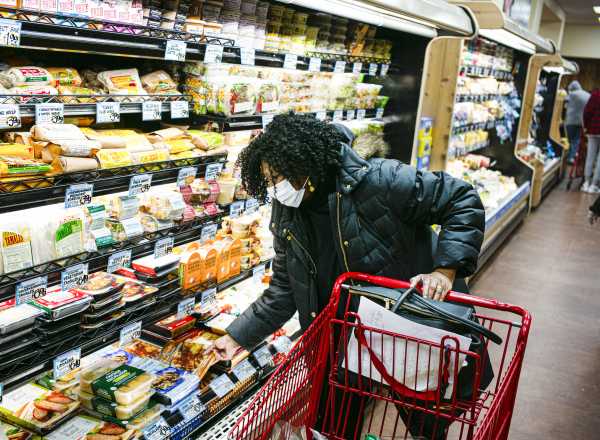
Your coronavirus grocery questions, answered by experts
Should I be using self-checkout? Are delivery services ethical? Where is the peanut butter?
By
Rachel Sugar
Mar 30, 2020, 3:50pm EDT
Share this story
-
Share this on Facebook
-
Share this on Twitter
-
Share
All sharing options
Share
All sharing options for:
Your coronavirus grocery questions, answered by experts
-
Reddit
-
Pocket
-
Flipboard
-
Email
This story is part of a group of stories called

In our collective attempt to flatten the curve, grocery shopping has become a minefield. We are not supposed to leave our homes, yet we have to keep feeding ourselves; as a result, what used to be a comforting annoyance now feels dangerous. Can you touch that cereal box? Why is that person standing so close?
There is a lot of guidance on how to handle the store, and a lot of it is confusing, if not contradictory. It’s okay to get groceries, we’re told, but not too often. You’re not supposed to wear a mask if you’re healthy, but perhaps you should. You probably aren’t going to get coronavirus from touching the wrong avocado, or at least, scientists say transmission from food is unlikely. Maybe it’s harder to find pasta now, but you shouldn’t panic about shortages.
To help us navigate this unsettling new world of grocery shopping — can you reuse your bags? why isn’t there yeast? — we turned to the experts.
What is the safest way to shop inside a grocery store?
While it may be possible to get sick by touching surfaces with the virus, the main way the virus spreads is thought to be person-to-person contact, according to the CDC. The big threat here isn’t pasta boxes; it’s other people.
So the first thing you want to do is minimize your shopping trips (or consider delivery). “If you can get it down to once every week or every two weeks, that’s great,” says Anne-Marie Gloster, a lecturer in the nutritional science program at the University of Washington. And as much as possible, shop at off-peak times, says Joshua Petrie, an assistant research professor of epidemiology at the University of Michigan’s School of Public Health. Some stores are limiting the number of shoppers inside at once, or marking every six feet along the checkout line, to show customers how far apart to stand. This is good. The emptier, the better.
Which means that, if you can: Go alone, and — again, if possible — without children, who love touching things. It’s also worth doing some planning before you go, says Gloster, both so you can move quickly once you’re in the store and so you don’t forget anything. This is your big biweekly chance.
The No. 1 priority is keeping physical distance from other people. At the same time, we know the virus can live on surfaces for at least some amount of time, so you do want to avoid touching stuff as much as possible. Gloster “strongly suggests” wiping down the handle of your shopping cart with disinfectant wipes; at this point, many stores have them by the carts.
Consider leaving your phone in your pocket, because your phone is gross. “It’s truly a spit vector,” she says, graphically. We spit on it, we fondle it, we put it down on stuff, we pick it up and rub it on our faces. Now is the time to revive the paper list.
Should I wear a mask and gloves to the store, if I can get them?
Given the current shortages, surgical masks and N95 respirators should probably be reserved for medical workers. “They’re so much more important for health care workers who are actually treating patients and are at a much higher risk of being infected,” says Petrie.
The guidance here could change — some experts suggest that more people should be wearing masks in public, leading to DIY efforts, though others worry protective gear offers a false sense of security. As far as gloves go, Gloster is fond of using an extra produce bag as a makeshift barrier while handling the rest of her produce.
Unless you’ve “been exposed and are displaying symptoms of the virus,” a CDC spokesperson told Time on March 27, the agency is not currently recommending wearing gloves or a mask when you venture outside. That’s not to say those recommendations couldn’t change — just that, as of this writing, the CDC isn’t advising it.
Is it okay to bring my own reusable bag, or is it better to just get paper or plastic ones and throw them away?
Reusable bags are fine — assuming you’re diligent about cleaning them. Under more normal circumstances, once a week would be okay. Right now, Gloster advises: “Wash them after you come back, every single time.”
As cleaning expert Jolie Kerr wrote for Vox, nylon and cotton grocery bags can be machine-washed in cold water and air-dried. If you have reusable bags that can’t be machine-washed, you can wipe them down with a disinfecting wipe or an all-purpose spray and a paper towel. You can refer to the Environmental Protection Agency’s list of Disinfectants for Use Against SARS-CoV-2 to determine if a cleaning agent meets the agency’s criteria for use against the coronavirus.
What about checkout? Should I use cash or credit? Is self-checkout safer?
If you have a contactless option like Apple Pay, that’s probably the best, Gloster says. (Keep your phone in your pocket until then.)
As for cash versus credit? “There’s no good answer here,” Gloster continues. Paying with plastic often means touching a pin pad; cash isn’t known for being especially clean. Self-checkout should reduce contact with a cashier — good for everyone! — but it requires you to touch surfaces other people are also touching.
However you pay, Petrie says, “the most important thing is washing your hands when you’re done.”
Should I be sanitizing my groceries once they’re at my house?
Probably not. There’s a lot we don’t yet know about the coronavirus, but touching infected surfaces “doesn’t seem to be the major way this virus spreads,” Petrie says.
“I am not recommending disinfecting your groceries,” Don Schaffner, a professor of food microbiology at Rutgers School of Environmental and Biological Sciences and host of the podcasts Food Safety Talk and Risky or Not?, told Vox. “This seems like being overly cautious. We don’t know of any cases of Covid-19 transmitted by food, nor of any cases transmitted by food packaging.”
That’s pretty much what the FDA is saying, too. In a statement on March 24, Frank Yiannas, the FDA’s deputy commissioner for food policy and response, noted that “there is no evidence of human or animal food or food packaging being associated with transmission of the coronavirus that causes Covid-19.”
“I’m doing the same things I’ve always done in terms of washing my produce,” says Petrie. “I’m not wiping down my packaging, or leaving it outside for three days, like I’ve seen in some stories.”
While it likely isn’t necessary to sanitize your groceries, you do want to wash your hands after handling packages and when you have finished putting items away.
A lot of stores have special hours reserved for people likely to be more vulnerable to the virus — older people, or people with compromised immune systems. Are those a good idea?
Opinions here vary, and there are, again, no simple answers. In an ideal world, people in high-risk groups would have someone who could do their shopping for them — whether a friend or a delivery service — so they wouldn’t have to leave the house at all. (If you’re the one doing that shopping, great! Follow the steps above.)
Given the world that exists, though, special shopping hours likely have benefits, assuming they’re not so popular that stores actually get busier during those times.
“But if those people are able to come in when there’s fewer people, and they can get help from the staff more easily, then I would think that would be a good thing,” Petrie says.
There’s another benefit, too, Gloster points out: Usually, these special hours are first thing in the morning, which means that the shelves are likely to be fully stocked. If it’s especially risky for you to go out at all, then it’s important you’re actually able to get what you need when you do.
Technically, I “have groceries” — I could definitely eat for a few more days — but it would really be better if I had more garlic and something other than beans. Does that justify shopping?
No. “Put it off, absolutely, as long as you can,” Gloster says. She recommends digging through your cabinets and pulling out all the older stuff you meant to use and never did (canned pineapple, weird ancient grains, etc.).
This is a great time to experiment, because you have no other choice. This is not a great time to get food poisoning, so err on the side of caution and toss what’s expired.
Is it safer for me to get my groceries delivered, even though there are still people involved in this process?
Yes. If you can swing it financially, it may be your best option, Petrie says, simply because you’re coming into contact with fewer people — and potentially, in the case of contactless delivery, no people at all.
Okay, but is it ethical? Am I just asking other people to shoulder the risk for me?
On the one hand: Yes, to avoid going out, where you might contract coronavirus, you are paying someone else to be out, where they might contract coronavirus.
At the same time, not ordering groceries — many of which are delivered by gig workers — means those delivery people don’t get paid, as Saru Jayaraman, director of the Food Labor Research Center at UC Berkeley, told Wired. And by getting delivery, it’s possible you’re helping cut down on crowds in stores.
One thing you can do is order from companies with better sick-leave policies for delivery workers. (Some independent contractors in Instacart’s fleet planned a strike on March 30 over the company’s policies.)
Another thing you can do: not be a jerk, as Jason Del Rey outlines at Recode. Opt for contactless delivery. Don’t dock ratings. Tip generously.
When does preparation cross over into hoarding?
According to Petrie, if you’ve got more than “two to three weeks” worth of food, you’re entering hoarding territory. (If you would like to watch other people hoard, it is a robust subgenre on TikTok.) Ethical considerations aside, that’s just not necessary: The country is not about to run out of food.
I keep hearing there’s plenty of food, so why does it feel like grocery stores are suddenly out of everything?
First of all, says Yossi Sheffi, a professor of engineering systems at MIT and the director of the MIT Center for Transportation, they’re not really out of everything — stores, for the most part, are still pretty well-stocked. “If you go in the morning, you’ll see stores that are full of stuff,” he says. It’s just that some of that stuff is selling out very, very quickly, and it takes suppliers time to respond to the change in demand.
And the demand is changing, explains Sunil Chopra, a professor of operations management at Northwestern. Consider the parable of toilet paper. Generally, toilet paper consumption is extremely consistent, and because everyone knows how much is selling every week, supply chains don’t need a lot of spare inventory sitting around — why would they? The demand is always the same.
Except now, it isn’t. Suddenly, everyone panics, and that manifests in the mass buying of toilet paper, which leads to a shortage, which leads to more panic, and the cycle repeats. However, “just because people have more toilet paper at home doesn’t mean they’re going to use more toilet paper. Your toilet paper consumption stays basically the same.” It’s an artificial shortage, and it should stabilize — he doesn’t see the mania for toilet paper lasting too long.
“The products for which you will see the biggest shortages are products where normal consumption is pretty stable,” Chopra says. An efficient supply chain won’t have lots of extra — if people consistently buy 100 jars of peanut butter a week, then that’s what they’ll make.
But the thing about peanut butter is that, unlike toilet paper, if you have more of it, you’re likely to eat more of it. “There will be some products where consumption actually goes up,” he says, “and peanut butter will be one of those products.” In those cases — foods where the increased demand is real — we should expect the shortages to go on slightly longer, until consumption dies down or supply chains adapt. We’re already starting to see that happening, as food and supplies that would have once gone to restaurants, stadiums, and universities get redirected to grocery stores or sold straight to consumers.
Are there any specific foods, or types of food, that are going to be especially hard to get?
Potentially. To continue with peanut butter: It’s also possible, explains Alex Scott, an assistant professor of supply chain management at Michigan State University, that in some cases, demand could stay high, and manufacturers might decide not to ramp up production. It’s expensive to drastically increase capacity, and it may only make sense if they expect the current, quarantine-level demand to go on for years. But if they don’t expect that — if they expect kids will go back to school and stop eating so much peanut butter at home, let’s say — then it’s likely not worth it. He anticipates that there indeed may be certain items that stay hard to get until life goes back to something like normal.
If a particular region producing a particular product were hit particularly hard by the virus, that could also temporarily cause problems. While we might see that an item is more scarce than usual, he’s not predicting bare shelves.
The biggest risk to the health of the supply chain may be if workers start to get sick. “If the illnesses surge,” the New York Times reports, “there could be a slowdown in production and distribution.” Even that, though, would likely happen in waves, Chopra says, stressing that policymakers need to prioritize the health and safety of front-line food workers — always, and especially now.
Everyone recommends getting groceries delivered, except slots are always full. Will capacity ever be added?
Probably someday? Last week, Instacart announced plans to hire 300,000 more shoppers over the next three months to meet drastically increased demand; Amazon announced it was hiring 100,000 more people for warehouse and delivery jobs; and the New York-based delivery service FreshDirect is both hiring and adding delivery slots.
Still, Scott doesn’t see it happening overnight. “You can’t ramp that up in a couple of days,” he says. “It’s a longer-term thing. You’ve got to buy the trucks, you’ve got to hire the drivers, you’ve got to get them in your systems. Of course, you can add incrementally week to week to week, but to really scale? I’d think it would be a matter of months,” he says.
Unlike the rush on toilet paper, though, Scott suggests the demand for delivery could be here to stay. “I think you’ll see long-term changes in behavior from this,” he says. Some number of people are trying these services for the first time, and liking them. “Obviously, we don’t know the future, but I don’t see delivery and e-commerce going down.”
Sourse: vox.com





